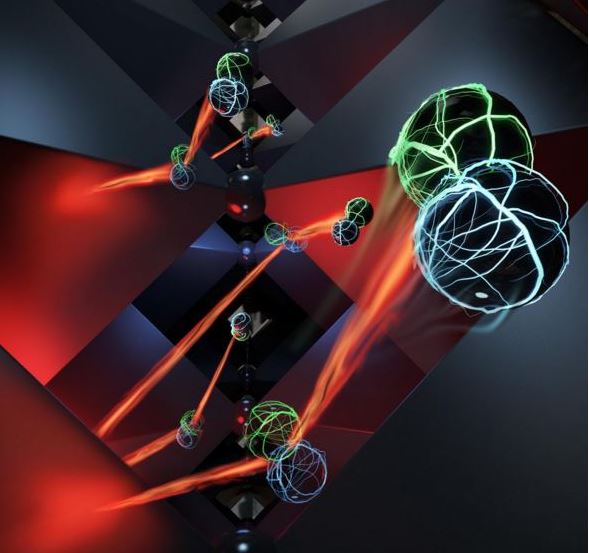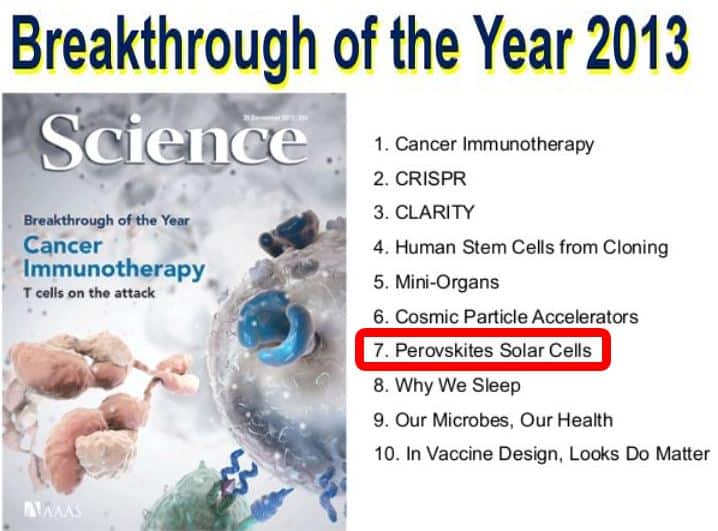Recycling light particles with perovskite materials could herald a new generation of high-performance, affordable, easy-to-make solar cells, says a team of scientists from the Universities of Oxford and Cambridge in England, and the FOM Institute AMOLF, Amsterdam, The Netherlands.
The researchers wrote in the journal Science (citation below) that they discovered an extremely promising group of materials known as hybrid lead halide perovskites.
These materials can recycle light and have the potential to achieve significant gains in the efficiency of solar cells.
 An artist’s impression of photon recycling inside the crystalline structure of perovskite. (Image: cam.ac.uk)
An artist’s impression of photon recycling inside the crystalline structure of perovskite. (Image: cam.ac.uk)
Perovskite-based materials could change whole industry
Hybrid lead halide perovskites are a group of synthetic materials that have been researched intensively over the past couple of years, because scientists believe they could revolutionise the whole solar energy sector.
Apart from being easy to produce and cheap, perovskite solar cells have rapidly become just about as energy-efficient as silicon – the material used today in the majority of domestic solar panels. Their efficiency can probably be improved considerably, the scientists believe.
By demonstrating that they can also be optimized to recycle light efficiently, this new study may have opened the door to a completely new area in the world of solar energy.
![]() Illustration of the photon recycling in perovskite semiconductors. (Image: amolf.nl/news)
Illustration of the photon recycling in perovskite semiconductors. (Image: amolf.nl/news)
Solar cells work by absorbing photons that come from the Sun to create electrical charges. However, the process can also work the other way round – when the electrical charges recombine, they can produce a photon.
A photon is the basic unit that makes up all light. It is a bundle of electromagnetic energy, sometimes referred to as a ‘quantum’ of electromagnetic energy.
Perovskite cells capable of photon recycling
In this study, the researchers discovered that perovskite cells are able to re-absorb the regenerated photons, in a process they called ‘photon recycling’. This creates a concentration effect within the cell, as if a lens had been used to channel lots of light into one single spot.
It should be relatively easy to exploit this ability to recycle photons to create cells that would lead to significantly more efficient solar panels.
This study builds on a previous one – a collaboration that focused on the use of these materials not only in solar cells, but also in light-emitting diodes.
That collaboration, and the current one, include the group of Richard Friend, Cavendish Professor of Physics and Fellow of St John’s College at the University of Cambridge, Henry Snaith’s team at the University of Oxford, and Bruno Ehrler at the FOM Institute AMOLF, Amsterdam.
 Perovskite-based solar cells made the top 10 breakthroughs of the year in 2013. (Image: Science Magazine)
Perovskite-based solar cells made the top 10 breakthroughs of the year in 2013. (Image: Science Magazine)
Efficiency could be further boosted
Corresponding author, Dr. Felix Deschler, who works at the Cavendish Laboratory, said:
“It’s a massive demonstration of the quality of this material and opens the door to maximising the efficiency of solar cells.”
“The fabrication methods that would be required to exploit this phenomenon are not complicated, and that should boost the efficiency of this technology significantly beyond what we have been able to achieve until now.”
Perovskite-based solar cells were initially tested in 2012. By 2013, due to their amazing success, Science Magazine rated them one of the year’s top breakthroughs.
Over the last three years, scientists have made rapid progress in improving the efficiency with which these cells convert light into electricity.
In recent experiments, conversion efficiencies of about 20% have been achieved – which is on a par with silicon cell performance.
By demonstrating that perovskite-based cells are also able to recycle photons, this new study suggests that they could reach far better efficiencies. In this study, the scientists shone a laser on to one part of a 500 nanometre-thick sample of lead-iodide perovskite.
Perovskites emit light when they come into contact with it, so the researchers were able to measure photon activity within the sample based on the light it emitted.
Near to where the laser light had shone on to the film, the scientists detected a near-infrared light emission. This emission, however, was also detected further away from the point where the laser struck the sample, together with a second emission composed of lower-energy photons.
Charges transported over long distances
Lead author, Luis Miguel Pazos Outón, who works at the Cavendish Laboratory, said:
“The low-energy component enables charges to be transported over a long distance, but the high-energy component could not exist unless photons were being recycled.”
“Recycling is a quality that materials like silicon simply don’t have. This effect concentrates a lot of charges within a very small volume. These are produced by a combination of incoming photons and those being made within the material itself, and that’s what enhances its energy efficiency.”
As part of the research, Pazos Outón also made the first demonstration of a perovskite-based back-contact solar cell.
This single cell was capable of transporting an electrical current over 50 micrometres away from the contact point with the laser. This was much further than the scientists had predicted, and a direct result of multiple photon recycling events that took place within the sample.
The scientists are convinced that the perovskite solar cells have the capacity to reach significantly higher efficiencies than they have so far.
Co-author, Richard Friend, who also works at the Cavendish Laboratory, said:
“The fact that we were able to show photon recycling happening in our own cell, which had not been optimised to produce energy, is extremely promising. If we can harness this it would lead to huge gains in terms of energy efficiency.”
Perovskite, named after Russian mineralogist Lev Perovski (1792–1856), is a calcium titanium oxide mineral composed of calcium titanate, with the chemical formula CaTiO3. The mineral was discovered in the Russian Ural Mountains by Gustav Rose in 1839.
In an Abstract in the journal, the authors wrote:
“Thus, energy transport is not limited by diffusive charge transport but can occur over long distances through multiple absorption-diffusion-emission events. This process creates high excitation densities within the perovskite layer and allows high open-circuit voltages.”
Citation: “Photon recycling in lead iodide perovskite solar cells,” Luis M. Pazos-Outón, Monika Szumilo, Robin Lamboll, Johannes M. Richter, Micaela Crespo-Quesada, Mojtaba Abdi-Jalebi, Harry J. Beeson, Milan Vrućinić, Mejd Alsari, Henry J. Snaith, Bruno Ehrler, Richard H. Friend1, Felix Deschler. Science. 25 March 2016. DOI: 10.1126/science.aaf1168.
Video – Perovskite solar cells made simply
Ordinary lab equipment is all you need to make Perovskite solar cells.
